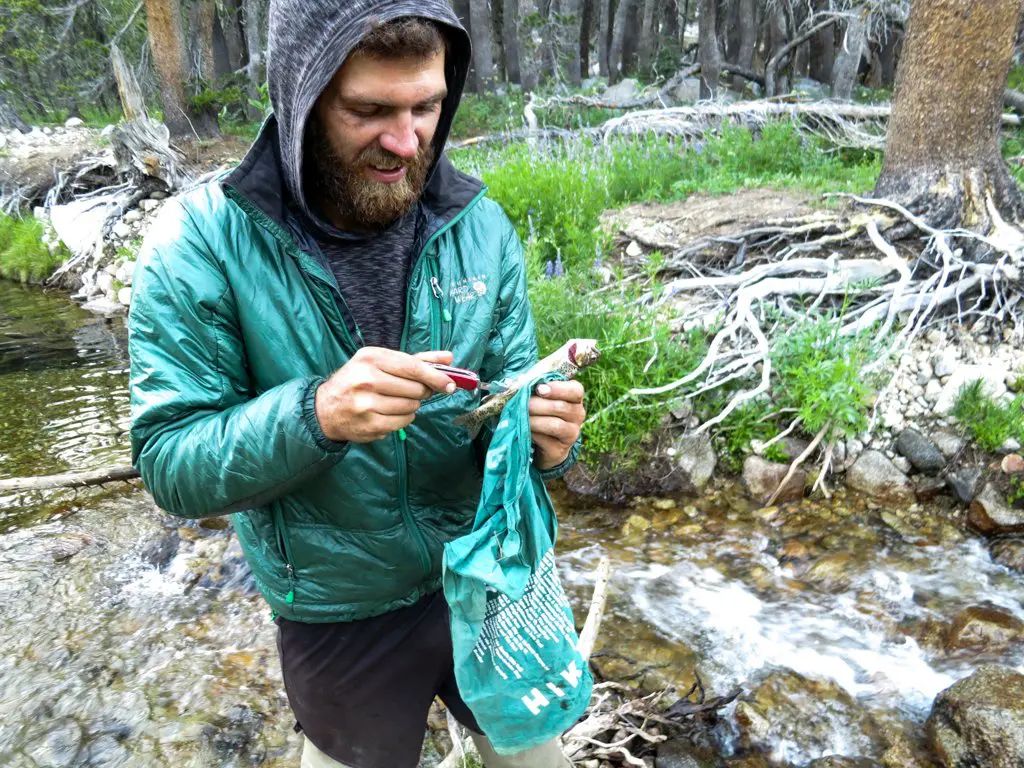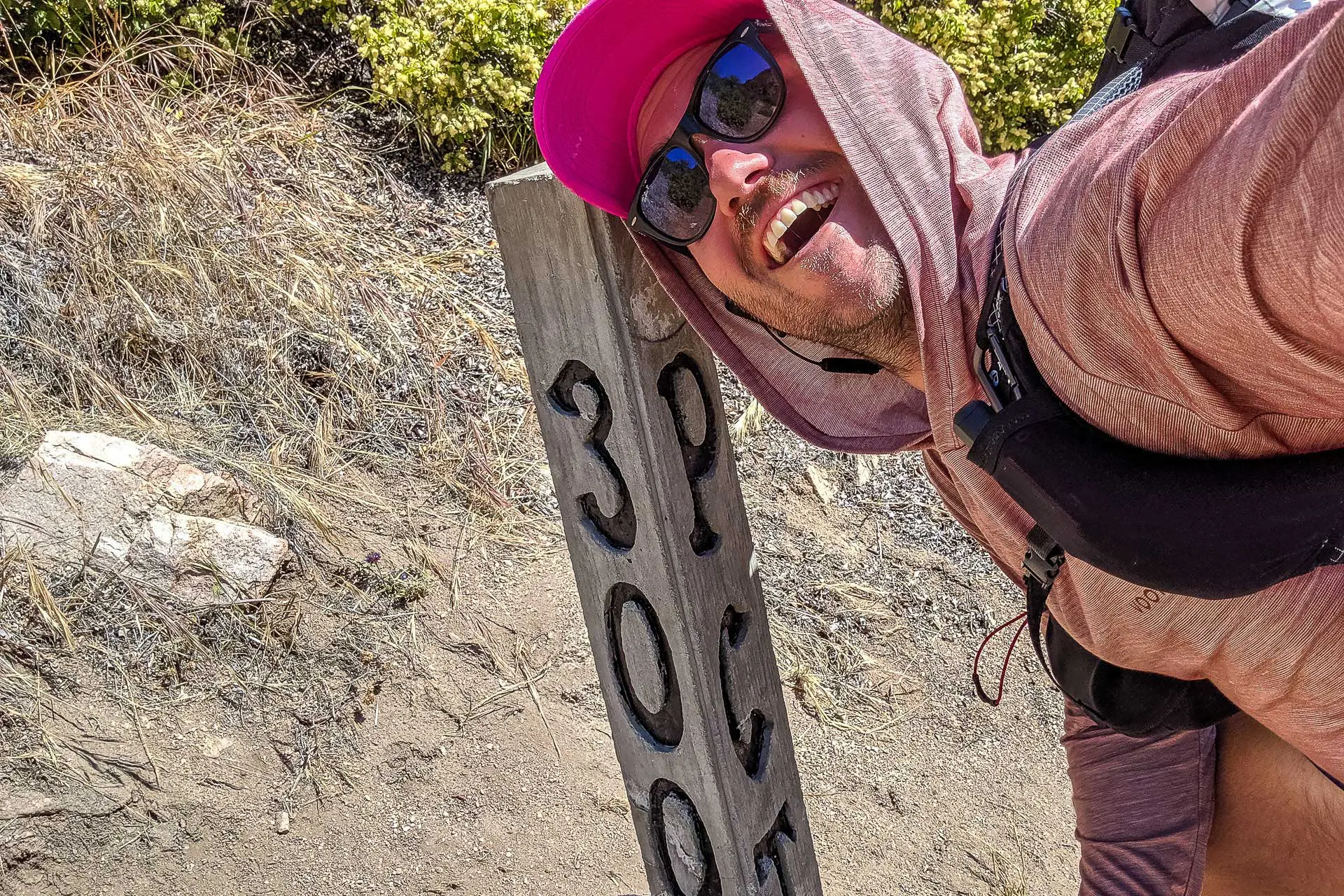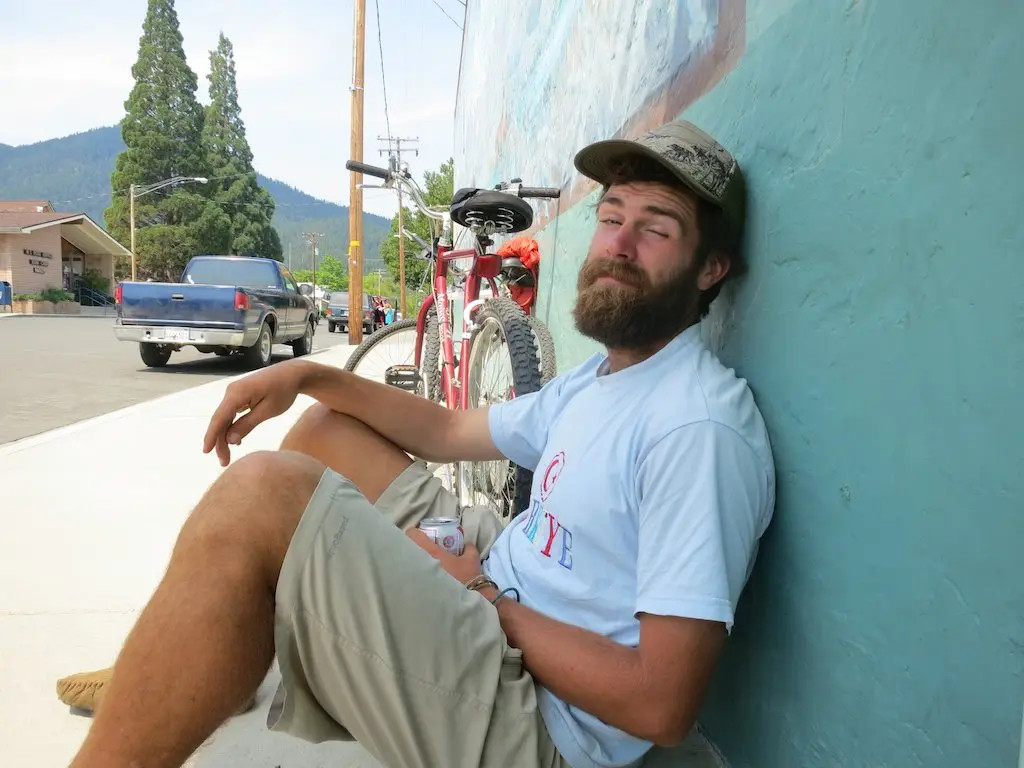Complete Pacific Crest Trail Gear List: Inside Appa the Sky Bison’s Backpack
I have already posted my Pacific Crest Trail gear list and my final gear list (compiled after the trail), but for many people (myself included), looking at what just one random dude decided to put in his pack is not enough.
Now I bring to you: another random dude. More specifically, Appa The Sky Bison (or Appa for short).

I met Appa on my Pacific Crest Trail thru-hike and I quickly manipulated him into becoming a good friend (despite his initial attempts to out-hike me and enjoy the crazy thoughts in his head alone).
This year Appa will be doing what I wish I was doing and hiking the PCT once more. Appa has shared his complete Pacific Crest Trail gear list with me and I have chosen to betray his trust and share it with the world.
From the man himself:
My 2013 gear was no-nonsense, high value, and minimalist. I’ll be using some of the same stuff for 2015, with a few upgrades that should improve comfort and safety while sacrificing simplicity. When buying gear, how does a hiker find the balance between being a drifter with a death wish and a gentrified REI model from Portlandia? Feel free to critique.
My gear philosophy revolves around two main ideas:
- V-Factor | What is the overall Value (V-factor) of an item? Includes: cost, durability, weight, versatility, and sex appeal.
- Lazy Points | How does this item make life on the trail simpler, easier, quicker, and lazier?
THE BIG STUFF
Note: Detailed descriptions (pros, cons, and notes) can be found below.
- BACKPACK: GoLite Jam 35 (26 oz / 737 g)
- SLEEPING BAG: Mountain Hardwear Phantom 32 Sleeping Bag (23 oz / 652 g)
- SHELTER: Zpacks Hexamid Tarp w/ Beak (6 oz / 170 g)
- SLEEPING PAD: Thermarest NeoAir Xlite (12 oz / 340 g)
- WATER FILTER: Sawyer Mini (2 oz / 57 g)
BACKUP AND SECTION GEAR
- UMBRELLA: GoLite Chrome Dome Umbrella (8 oz / 227 g)
- GROUNDSHEET: Tyvek (5 oz / 142 g)
- TENT: Big Agnes Fly Creek UL 1 (30 oz / 850 g)
- SLEEPING BAG LINER: Sea to Summit Reactor (8 oz / 227 g)
- BEAR CANISTER: BV-500 (41 oz / 1162 g)
CLOTHING
- SHIRT: Cheap synthetic tee
- SHORTS: Cheap synthetic gym shorts WITH POCKETS
- UNDIES: ExOfficio synthetic boxer briefs
- SOCKS: Merino wool crew (any brand) – two pairs
- WARM TOP: Icebreaker merino hoodie (15 oz / 425 g)
- WARM BOTTOMS: Cheap, synthetic pants with ankle zips (just loose enough for town)
- SHELL: DriDucks Jacket (5 oz / 142 g)
- HAT: Baseball hat (mesh back)
- WARM HAT: Beanie
- GLOVES: Cheap wool (tourist) gloves
- SUNGLASSES: Cheap sunglasses (lose, replace, repeat)
- SHOES: Topo MT Trail Runners (9 oz / 255 g)
- DOWN JACKET: Mountain Hardwear Compressor (15 oz / 425 g)
- HEAD NET: Cheap head net for Sierra onward
LITTLE BOY’S ROOM
- WIPING: Wad of toilet paper in Ziploc
- BRUSHING: Toothbrush
- FLOSSING: Floss
- DIGGING: Titanium trowel (poop holes)
- WASHING: Hand sanitizer
- AIDING: Triple antibiotic
ELECTRONICS
- PHONE: iPhone 5S (4 oz / 113 g)
- CASE: Otterbox Preserver Case (3.5 oz / 99 g)
- APPS: Halfmile and Guthook
- HEADPHONES: Cheap ear buds
- CHARGER: USB wall adapter
- CORDS: iPhone and micro USB cords
EVERYTHING ELSE
- HEADLAMP: Old piece of junk (6 oz / 171 g)
- KNIFE: Sentimental Swiss Army knife*
- WATER: (2) 1.5L Smart Water Bottles (.5 oz / 14 g)
- WATER: Platypus Big Zip EVO Reservoir (2 oz / 57 g)
- FOOD BAG: Sea to Summit Ultra-Sil Stuff Sack (.5 oz / 14 g)
- PACK LINER: Trash Compactor Bag (1 oz)
- MAPS: Paper Halfmile maps for some sections
- PERMITS: Hiker permits (buried deep in the bottom of my pack)
- LIGHTER: Bic (big one)
- WRITING: Sharpie, pen, and paper
- AND OF COURSE: Ziplocs
NOTES
- Going stoveless is a revolution. No more do I live within society’s constructs of “meals”. I eat when, and what I want to, and it is phenomenally freeing. Couscous and tortillas are your friends.
- My merino hoody is still my favorite piece of gear. It’s worth every luxury ounce for me. I picked up a thinner version for this year and I can wear it comfortably to 80 degrees hiking, then hug an old lady without offending her by my stench, and then go to sleep in it. Hoodies are as comforting as homemade pancakes. However, it is heavy, and not essential for survival.
- If you can’t reach your water bottles from your pack without taking it off, get a hydration bladder. Simple.
GEAR INSIGHTS
BACKPACK: GoLite Jam 35
PROS: Cheap, durable, great hip belt pockets, and compressible. I prefer a frameless bag for body-hugging flexibility. I feel more like a ninja, less like a marine.
CONS: Does not hold the BV-500 comfortably. Shoulder pads are too thin at 30+ lbs / 13.5+ kg. Needs a big mesh pocket on the back. Cannot reach water bottles with the pack on. GoLite went under so the pack is no longer available and they plastered their name all over the pack.
WEIGHT/MSRP: 26 oz / 737 g / $100
Find out more
CONCLUSION:There are packs out there better at the same things, but this pack chose me and I will not betray it until it betrays me. Anyone have good ideas on how to attach a mesh pocket to the outside?
When packed strategically, a frameless pack like my out of production GoLite Jam 35 becomes pretty rigid, and can be worn different ways to carry weight on the hips or shoulders. I like to move the weight around depending on how it’s feeling. The Jam scores high on V-Factor since it only put me back 100 bones and has lasted for a full thru-hike and it on #2 with minimal repairs.
SLEEPING BAG: Mountain Hardwear Phantom 32
PROS: Very compressible, fits like a glove, and no matter the abuse the down keeps re-lofting after a bath and gentle massage. REI Employee discount.
CONS: Hard to get out of when fully zipped and you’re going to pee yourself. Has a love/hate relationship with moisture. Where’d all those feathers come from?
WEIGHT/MSRP: 23 oz / 652 g / $220
Find out more
NOTES: I would not replace at full price, but would consider at a discount. High rated down is worth the extra cash. Since I’m using a bivy, a quilt style bag would work for me, reducing claustrophobic episodes (see ZPacks quilts). The Phantom Sleeping Bag is old and only good to about 45°F/7°C these days, but my liner keeps it surprisingly warm. Regardless, the bag is at the top of the list of gear to replace.
SHELTER: ZPacks Hexamid Tarp w/ Beak
PROS: I love the PCT for all the cowboy camping! Be one with nature my friends, “we are all made of star stuff.” -Neil Degrasse Tyson. My tarp only goes up in a storm. Cuben fiber disappears in my pack when not needed. Cuben fiber does not absorb moisture. No more lugging around the extra weight of a water-logged nylon tarp. Bought used.
CONS: I’ve only set it up in good weather, could be a major nuisance in a storm, but what isn’t? The cuben fiber is tissue-thin, will it hold up to my style of thru-hike? My style = no stuff sacks. Lots of stakes to carry and lose.
WEIGHT/MSRP: 6 oz / 170 g / $180
Note: Also carried 8 stakes (6 titanium shepherd hooks and 2 beefy guys) weighing 2 oz / 57 g total.
NOTES: Only the trail will tell, but as a shelter, it is definitely an upgrade from the GoLite poncho/tarp I used in 2013. Just in case I have a Big Agnes Fly Creek 1 ready and waiting. The blue cuben screams thru-hiker decadence. Y’all haters.
SLEEPING PAD: Therm-a-Rest NeoAir Xlite (R)
PROS: Provides a warm and comfortable night for a side sleeper. It packs small and if protected from pokeys, will last longer than a foam mat.
CONS: Blowing up and deflating! This is a major shift from my lazy hiking style. It cannot be utilized as a sitting, yoga, or waterside mat. When rolling around it creates a crunchy paper noise that may annoy others, but I don’t mind. Useless if it blows a seam, otherwise can be field patched. Accumulates saliva inside which adds weight, can freeze, and is gross. Thru-hiker decadence.
WEIGHT/MSRP: 12 oz / 340 g / $115
Find out more
NOTES: Switching to an inflatable mattress has been interesting since it openly defies the idea of Lazy Points (blowing up, deflating, and rolling up are all added chores), but memories of waking up with a numb limbs from sleeping on them have remained distant as I have had consistent lovely slumbers on the NeoAir. Each evening I’m becoming increasingly excited to blow it up and lay down. I guess this is what getting old means.
WATER FILTER: Sawyer Mini
PROS: Smaller and lighter than the original Sawyer Squeeze. Charcoal filtered water is delicious.
CONS: Apparently clogs easier than the original and squeezing gets old. It also is susceptible to freezing and breaking.
WEIGHT/MSRP: 2 oz / 57 g / $20
Find out mroe
CONCLUSION: Chemicals and giardia are off the table. The system of squeezing one SmartWater bottle, through the filter, and into another bottle or reservoir can be painstaking but is durable, reliable, and one time a hummingbird landed on my bare foot while squeezing. Recognize signs, people.
FURTHER READING: Check out Halfway Anywhere’s detailed Sawyer Mini review here.
THE FINAL SAY
When all is said and done, the base weight of this rig falls between 9-11 lbs.
The less stuff you carry, the more food you can pack, the longer you can stay in paradise.
Walk easy.
Disclosure: This page contains affiliate links which means at no additional cost to you, I may receive small commissions for purchases made via these links. This helps keep the site up and running.











![A person is lounging outdoors with a scenic forest view, surrounded by hiker food essentials like a backpack, fly rod, and cooking equipment. Overlaid text reads [cal/oz] ≥ 100, showcasing the perfect formula for an adventurous day in nature.](https://www.halfwayanywhere.com/wp-content/uploads/2014/02/View-From-Lunch-Spot-PCT-Cooking-Formula.png)
Just sending some love. This is now my favourite pack list, even if it is 4 years old, I care for other pack lists no more. V factor extremely high.
The Appa will be very pleased to hear this.
Hey Mac, you beautiful vagabond.
Hey there, good lookin.
Jesse, my packing technique is such: first my sleeping bag gets stuffed into a trash compactor bag, which I then roll up to keep my down nice and dry. Next goes the neo air, and food bag (after removing lunch/snacks for the day). Depending on how much food I have left, I pack the rest a bit differently every day in order to keep the weight balanced in my flimsy frame less pack. I like to have my wool hoodie, snacks, rain gear, and tarp on top for quick access. With everything in there loose (the no stuff sack way), it can get disorganized quickly, but after countless repetitions of packing and unpacking, knowing where everything settles in the pack becomes a second sense. Thanks for the question!
Appa, what is your packing technqiue (The no stuff suck way)
Hey Appa, did you use trekking poles? I see you using the Zpacks shelter, but you don’t list a pole you use to stand it up, which leads me to believe you use trekking poles so that you can stand up your shelter with one of them. I see you bring an umbrella, though, so that leads me to believe that you don’t use trekking poles. Do you, or don’t you? :)
Howdy future hiker, I did start with trekking poles. They are an old pair of black diamond carbon-fiber poles that have done me well. After about 700 miles this year, I found myself strapping the poles to my pack more often than using them (got my trail legs back). So I sent one home and kept the other for the tarp, that is, until I switched out the tarp for a freestanding tent (Big Agnes Fly Creek UL1) due to the difficulty of setting up the tarp on snow in the Rockies through Colorado.
While umbrella’s seem to work great for others, I found it too distracting, especially when windy. Instead, when the sun was beating down, I preferred to put my wool hoodie on, and slow my pace to adjust for the heat. Thanks for asking.